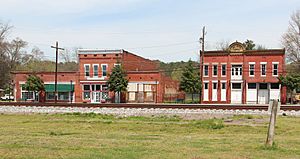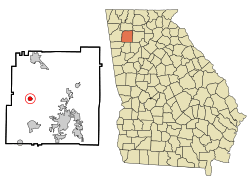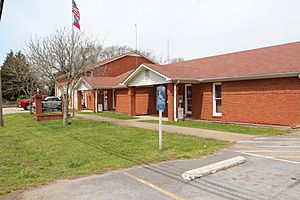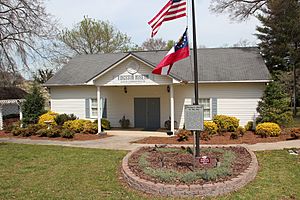Kingston, Georgia facts for kids
Quick facts for kids
Kingston, Georgia
|
|
|---|---|

Kingston historic district
|
|

Location in Bartow County and the state of Georgia
|
|
| Country | United States |
| State | Georgia |
| County | Bartow |
| Area | |
| • Total | 1.26 sq mi (3.26 km2) |
| • Land | 1.26 sq mi (3.26 km2) |
| • Water | 0.00 sq mi (0.00 km2) |
| Elevation | 702 ft (214 m) |
| Population
(2020)
|
|
| • Total | 722 |
| • Density | 573.47/sq mi (221.47/km2) |
| Time zone | UTC-5 (Eastern (EST)) |
| • Summer (DST) | UTC-4 (EDT) |
| ZIP code |
30145
|
| Area code(s) | 770/678/470/943 |
| FIPS code | 13-43668 |
| GNIS feature ID | 0332152 |
Kingston is a small city in Bartow County, Georgia, United States. In 2020, about 722 people lived there.
Contents
Geography of Kingston
Kingston is located in the western part of Bartow County. You can find it at these coordinates: 34°14′9″N 84°56′41″W / 34.23583°N 84.94472°W.
The United States Census Bureau says the city covers about 3.3 square kilometers (1.26 square miles) of land. There is no water area within the city limits.
Georgia State Route 293 (Kingston Highway) goes right through the middle of town. It leads southeast about 11 miles to Cartersville. To the west, it goes about 13 miles to Rome. Another main road, U.S. Route 411, is a four-lane highway. It passes about 1 mile south of Kingston and also connects Cartersville and Rome.
Kingston's Past: A Look at History
Early Inhabitants and Town Naming
Long ago, Native American tribes lived in the Kingston area. People of the Mississippian culture were here until around 1500 AD. The Cherokee removal forced the Cherokee people out of this area by 1838. White settlers began moving in as early as 1832. This happened after a land lottery. The city was named after John Pendleton King, who was a United States Senator from Georgia.
The Great Locomotive Chase
On April 12, 1862, a famous event called the Great Locomotive Chase happened here. James J. Andrews and 18 Union soldiers, dressed as civilians, stole a train called The General. They took it from Big Shanty (now Kennesaw). Their plan was to damage the Western and Atlantic Railroad. But they had to stop in Kingston to let other trains pass. After a long wait, The General continued north. The train conductor, William Allen Fuller, chased them. He used a push-car and other ways to catch the hijackers.
Civil War Hospitals in Kingston
During the Civil War, from 1862 to 1864, Kingston had Confederate hospitals. Many soldiers were treated here for wounds and sickness. These soldiers were hurt in battles like Perryville and Chickamauga. In May 1864, the patients were moved to Atlanta. This was to keep them safe from Union forces. The Union army later used these hospitals.
General Sherman and the Atlanta Campaign
Union general William T. Sherman stayed in Kingston from May 16 to 19, 1864. He used the Hargis House as his headquarters. He was getting his troops ready for the Atlanta Campaign. Sherman thought the Confederate army had moved towards Kingston. So, he gathered his forces here. But he soon found out the Confederates had gone to Cassville.
On May 18, 1864, Confederate troops under Lieutenant General William J. Hardee marched near Kingston. They were heading to Cassville to join other Confederate forces. Sherman's mistake in thinking all Confederate troops were coming to Kingston led him to gather his army here. He later realized the Confederates were about 5.5 miles east in Cassville.
On May 19, 1864, Union generals Daniel Butterfield and Joseph Hooker were also in Kingston. They were staying at the home of Colonel Hawkins F. Price. Hooker had been told to come to Kingston because of false reports. He later found out the Confederate army was in Cassville.
Union forces, including the IV Corps and XIV Corps, reached Kingston on May 19. They then moved east towards Cassville. Other Union corps, like the XV Corps and XVI Corps, camped nearby. Sherman's forces stayed in Kingston until May 23. Then, they began to move across the Etowah River.
End of the Civil War and Memorial Day
The first Memorial Day, also called Decoration Day, may have been observed in Kingston in late April 1865. People here say it has been celebrated every year since then. This first observance happened while Union troops were still in town. Flowers were placed on both Confederate and Union graves.
However, some historians, like Bellware and Gardiner, question this claim. They say the timing and locations of generals in April 1865 make it unlikely.
On May 12, 1865, Confederate Brigadier General William T. Wofford surrendered his soldiers in Kingston. He surrendered about 3,000 to 4,000 troops to Union Brigadier General Henry M. Judah. These were some of the last major Confederate soldiers to surrender east of the Mississippi River. Most of these soldiers were from Georgia. General Wofford's headquarters were at the McCravey-Johnson residence. General Judah's headquarters were at Spring Bank, about 2 miles north of Kingston. The Union army provided food for the Confederate soldiers.
Population and People
| Historical population | |||
|---|---|---|---|
| Census | Pop. | %± | |
| 1870 | 402 | — | |
| 1880 | 483 | 20.1% | |
| 1890 | 559 | 15.7% | |
| 1900 | 512 | −8.4% | |
| 1910 | 522 | 2.0% | |
| 1920 | 596 | 14.2% | |
| 1930 | 553 | −7.2% | |
| 1940 | 653 | 18.1% | |
| 1950 | 675 | 3.4% | |
| 1960 | 695 | 3.0% | |
| 1970 | 714 | 2.7% | |
| 1980 | 733 | 2.7% | |
| 1990 | 616 | −16.0% | |
| 2000 | 659 | 7.0% | |
| 2010 | 637 | −3.3% | |
| 2020 | 722 | 13.3% | |
| 2023 (est.) | 902 | 41.6% | |
| U.S. Decennial Census | |||
In 2000, there were 659 people living in Kingston. There were 248 households and 191 families. The city had about 817 people per square mile.
About 68.6% of the people were White. About 29.6% were African American. A small number of people were Pacific Islander or from other races. About 1.5% of the population was Hispanic or Latino.
About 32.7% of households had children under 18 living with them. About 49.2% were married couples. The average household had 2.66 people. The average family had 3.04 people.
The population was spread out by age. About 26.1% were under 18. About 10.3% were between 18 and 24. About 26.3% were between 25 and 44. About 24.3% were between 45 and 64. And 13.1% were 65 or older. The average age was 36 years.
Places to Visit and See
- Kingston has a small museum. It also has several historical spots. These places tell stories about the Civil War. They also share the history of the Native American tribes who once lived there.
- The Kingston Saltpeter Cave is south of the city. It is the biggest cave in Bartow County. During the Civil War, the Confederacy used it. They made gunpowder there. The cave is not open to the public.
Here are some historic markers in the Kingston area:
- Confederate Memorial Day
- Hardee's Corps at Kingston
- Historic Price House
- The Site of the Thomas V. B. Hargis House is about 2.5 miles northeast.
- Kingston Methodist Church: The first Methodist church was built in 1845. It was rebuilt in Kingston in 1854. It was the only church left after Sherman's march. It welcomed all religions and was also Kingston's school for many years.
- Old Macedonia Church, started in 1847.
- Spring Bank
- A marker in Kingston, Georgia (Bartow County), shows where Confederate troops surrendered after the war.
- The Federal Army at Kingston
Famous People from Kingston
- Rap Dixon was a baseball player. He played in the Negro leagues.
See also
 In Spanish: Kingston (Georgia) para niños
In Spanish: Kingston (Georgia) para niños



